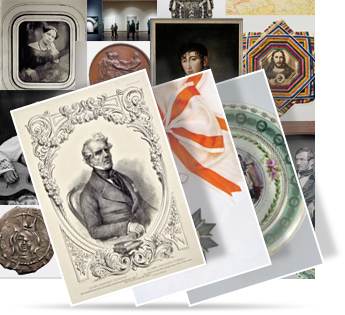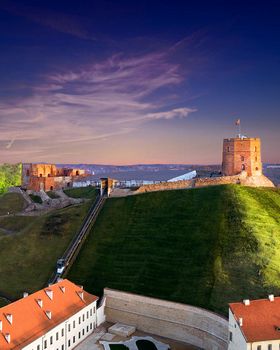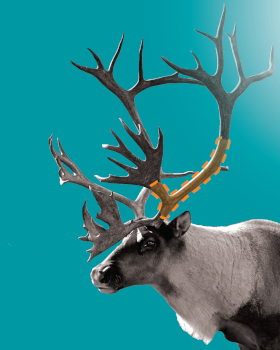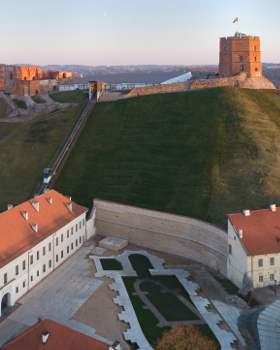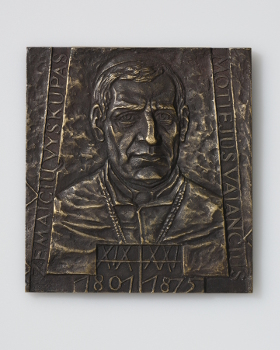Exposition Locations
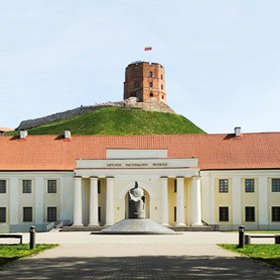
The New Arsenal
| Monday | Closed | Additional information |
| Tuesday | 10.00 – 18.00 | |
| Wednesday | 10.00 – 18.00 | |
| Thursday | 10.00 – 18.00 | |
| Friday | 10.00 – 18.00 | |
| Saturday | 10.00 – 18.00 | |
| Sunday | 10.00 – 18.00 |
Excursions
Guided tours are available in the Lithuanian, English and Russian languages. Guided tours must be ordered in advance by phone, e-mail or by filling this form: press here.
Tel. +370 (5) 262 94 26
E-mail: [email protected]
Information for disabled visitors: the ground floor of the New Arsenal has wheelchair access.
The tours in the museum are only led by the museum tour guides or the tour guides from the institution with which the museum has concluded an appropriate agreement.
General visitor regulations of the National Museum of Lithuania
 The New Arsenal is one of the oldest buildings of the complex of Vilnius Castles. Archaeological investigations have revealed that in the 14th century a brick Gothic building stood in this location. The exterior wall of the building also served as a defensive wall of the castle. In the 1545 map of the city of Vilnius by Franz Hoogenbergh there is a long, one-storey brick architectural structure in the place of a current building. The eastern part of the structure had a tower, i.e. “lighthouse”, which had to assist in the navigation of barges on the Neris River. However, the purpose of the entire structure is not indicated. A later Fürstenhoff plan made in 1737 depicts a building joined with other two parallel buildings by a transverse edifice in the same location. This entire complicated ensemble comprised servant houses and outbuildings of the estate of a Grand Duke. There is a presumption that in 1648-1794 the court of Castle jurisdiction and administration were located in this building.
The New Arsenal is one of the oldest buildings of the complex of Vilnius Castles. Archaeological investigations have revealed that in the 14th century a brick Gothic building stood in this location. The exterior wall of the building also served as a defensive wall of the castle. In the 1545 map of the city of Vilnius by Franz Hoogenbergh there is a long, one-storey brick architectural structure in the place of a current building. The eastern part of the structure had a tower, i.e. “lighthouse”, which had to assist in the navigation of barges on the Neris River. However, the purpose of the entire structure is not indicated. A later Fürstenhoff plan made in 1737 depicts a building joined with other two parallel buildings by a transverse edifice in the same location. This entire complicated ensemble comprised servant houses and outbuildings of the estate of a Grand Duke. There is a presumption that in 1648-1794 the court of Castle jurisdiction and administration were located in this building.
During the second half of the 18th century, the building was transformed into barracks following the decree of Grand Hetman of the Grand Duchy of Lithuania Michal Kazimierz Oginski and its name was changed to the New Arsenal. Following the reconstruction, the altered exterior of the building has remained until the present day.
At the beginning of the 19th century, a portico of massive columns was added in the centre of the facade. In 1960-1965 the building was renovated substantially and was adjusted to house the expositions of the National Museum of Lithuania in 1968.
| Tickets | |
| Adults | 4,00 € |
| Reduced price ticket* | 2,00 € |
| Family ticket | |
| 1 Adult and 1–3 minor children | 6,00 € |
| 2 Adults and 1–3 minor children | 10,00 € |
| Additional services | |
| A guided tour in Lithuanian for a group of up to 20 people (60 min) | 10,00 € |
| A guided tour in a foreign language for a group of up to 20 people (60 min) | 15,00 € |
| Audioguide | 1,00 € |
| Price of an educational class for a school pupil | 1,00 € |
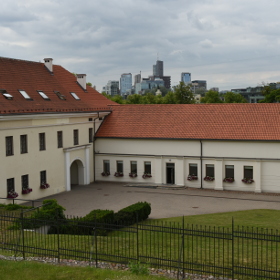
The Old Arsenal
| Monday | Closed | Additional information |
| Tuesday | 10.00 – 18.00 | |
| Wednesday | 10.00 – 18.00 | |
| Thursday | 10.00 – 18.00 | |
| Friday | 10.00 – 18.00 | |
| Saturday | 10.00 – 18.00 | |
| Sunday | 10.00 – 18.00 |
Excursions
Guided tours are available in the Lithuanian, English and Russian languages. Guided tours must be ordered in advance by phone, e-mail or by filling this form: press here.
Tel. +370 (5) 262 94 26
E-mail: [email protected]
Information for disabled visitors: exhibition halls of the Old Arsenal have wheelchair access.
The tours in the museum are only led by the museum tour guides or the tour guides from the institution with which the museum has concluded an appropriate agreement.
General visitor regulations of the National Museum of Lithuania
 According to the archaeological investigations, it is considered that the castle arsenal had already been erected in the 15th century, i.e. during the times of Grand Dukes of Lithuania Vytautas and Casimir. Later, the arsenal fell into a state of disrepair and was reconstructed only in 1507, when Sigismund the Old became the Grand Duke of Lithuania. Vilnius Castellan Ulrich Hosius supervised the construction works. During the reign of Sigismund Augustus, Vilnius Castellan, engineer and architect Hiob Braitfus continued the construction works of the arsenal. The eastern block of the arsenal was built at the beginning of the 16th century incorporating a part of the old defensive wall, whereas the northern and western blocks of the arsenal were erected in the middle of the 16th – the beginning of the 17th centuries. The dimensions of the then Vilnius Castle Arsenal can be traced from the 1560 report of a Venetian messenger stating that Sigismund Augustus had 180 heavy cannons as well as numerous smaller nicely decorated artillery guns in Vilnius.
According to the archaeological investigations, it is considered that the castle arsenal had already been erected in the 15th century, i.e. during the times of Grand Dukes of Lithuania Vytautas and Casimir. Later, the arsenal fell into a state of disrepair and was reconstructed only in 1507, when Sigismund the Old became the Grand Duke of Lithuania. Vilnius Castellan Ulrich Hosius supervised the construction works. During the reign of Sigismund Augustus, Vilnius Castellan, engineer and architect Hiob Braitfus continued the construction works of the arsenal. The eastern block of the arsenal was built at the beginning of the 16th century incorporating a part of the old defensive wall, whereas the northern and western blocks of the arsenal were erected in the middle of the 16th – the beginning of the 17th centuries. The dimensions of the then Vilnius Castle Arsenal can be traced from the 1560 report of a Venetian messenger stating that Sigismund Augustus had 180 heavy cannons as well as numerous smaller nicely decorated artillery guns in Vilnius.
In the 18th century the arsenal was named the Old Arsenal. The exterior of the arsenal buildings had remained practically unchanged until 1834, when the engineers of the Russian military headquarters made their inventories and performed reconstruction works. The eastern block of the Old Arsenal was transformed into an artillery warehouse of the tsarist army. The northern block was rearranged to house the barracks and a warehouse, whereas flats for officers were built in the western block of the arsenal. At the beginning of the 20th century, the Old Arsenal was reconstructed and its major part was demolished during the World War II.
In 1987, a reconstructed eastern block of the Old Arsenal was adjusted to meet the needs of the Art Museum. In 1997, reconstructed northern and western blocks of the Old Arsenal were adapted for use as the National Museum of Lithuania.
| Tickets | |
| Adults | 4,00 € |
| Reduced price ticket* | 2,00 € |
| Family ticket | |
| 1 Adult and 1–3 minor children | 6,00 € |
| 2 Adults and 1–3 minor children | 10,00 € |
| Additional services | |
| A guided tour in Lithuanian for a group of up to 20 people (60 min) | 10,00 € |
| A guided tour in a foreign language for a group of up to 20 people (60 min) | 15,00 € |
| Price of an educational class for a school pupil | 1,00 € |
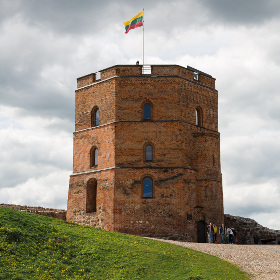
Gediminas Castle Tower
| Monday | 10.00 – 18.00 | Additional information |
| Tuesday | 10.00 – 18.00 | Ticket office closes at 17.30 .
The gate of the fence surrounding the Gediminas hill fort is closed from 20.00 to 10.00.
|
| Wednesday | 10.00 – 18.00 | |
| Thursday | 10.00 – 18.00 | |
| Friday | 10.00 – 18.00 | |
| Saturday | 10.00 – 18.00 | |
| Sunday | 10.00 – 18.00 |
Excursions
Guided tours are available in the Lithuanian, Russian and English languages. Guided tours must be ordered in advance by phone, e-mail or by filling this form: press here.
tel. +370 (5) 261 74 53, +370 (5) 212 26 17
E-mail: [email protected]
Information for disabled visitors: exhibition halls of the Gediminas Castle Tower do not have wheelchair access.
1 hour filming with professional equipment on the Gediminas scenic overlook – 20,00 EUR. Exposition filming is permitted only with the consent of the administration.
The tours in the museum are only led by the museum tour guides or the tour guides from the institution with which the museum has concluded an appropriate agreement.
General visitor regulations of the National Museum of Lithuania
 The Castle Hill surrounded by rivers was a convenient location to build a castle and establish a bigger settlement. Archaeological investigations have revealed that there had already been a settlement on the Castle Hill in the Neolithic. In the 9th century, the hill was reinforced with wooden and stone fences, whereas in the 11th-13th centuries a wooden castle had already been erected. The early history of the castle is closely related to the history of the development of the city.
The Castle Hill surrounded by rivers was a convenient location to build a castle and establish a bigger settlement. Archaeological investigations have revealed that there had already been a settlement on the Castle Hill in the Neolithic. In the 9th century, the hill was reinforced with wooden and stone fences, whereas in the 11th-13th centuries a wooden castle had already been erected. The early history of the castle is closely related to the history of the development of the city.
During the reign of Grand Duke of Lithuania Gediminas, Vilnius was already known as the capital of the Grand Duchy of Lithuania, and the Vilnius Castle was mentioned for the first time in the 1323 treaty between Gediminas and the Teutonic Order. Often the Higher Castle is referred to as the Gediminas Castle. During the reign of the first rulers from the Gediminid dynasty the Vilnius Higher Castle was of great significance not only as a political centre of the Grand Duchy of Lithuania, but also as a constituent element of the defensive complex of the capital (together with the Lower and Crooked Castles) that withstood an intensified attack of the Teutonic Order during the second half of the 14th century. When a fire destroyed the wooden castle, a brick castle was constructed during the reign of Grand Duke of Lithuania Vytautas at the beginning of the 15th century. The remains of the brick castle have survived until the present day.
Eventually, as the situation in the state changed, the castle lost its purpose and subsequent fires and wars, after which it was not repaired, devastated the castle. During 1610-1613, a prison functioned in the basement of the castle, whereas the Higher Castle was last used as a defensive fortress during the war in 1655-1661. The Muscovite army was temporarily settled in the castle. Afterwards, the castle was completely desolated and was slowly disintegrating and declining.
The defensive functions of the castle were brought to light in the 19th century, when a fortress was established in the territory of Vilnius castles following the order of the Tsar of Russia in 1831. The ruins of the Higher Castle were also taken care of, i.e. the remains of the southern and northern towers of the Higher Castle as well as its western and northern walls were demolished, the masonry was conserved, and a sloping Castle Hill was reinforced. In 1838, a wooden two-storey structure of optical telegraph was erected on top of the western tower. When the fortress was removed from the territory of Vilnius castles, a new road was built on the slope of the Castle Hill in 1896, the slopes were planted with trees, and a café was opened in the western tower. During the interwar period, the conservation works were carried on.
When Lithuania restored its state in 1918, the flag of Lithuania was first hoisted on the Gediminas Castle Hill on January 1, 1919. Unfortunately, this was not for long. Vilnius region was occupied by the Polish and only on October 29, 1939 the tricolour of Lithuania was hoisted again on the castle tower. During the World War II the western tower of the castle was damaged badly.
After the war, although Lithuania was occupied by the Soviet Union, the tower was rebuilt and, in 1960, when the territory of the hill was arranged and the fragments of the castle buildings were conserved, the Castle Museum was opened in the western tower. From 1968, the museum became the subdivision of the National Museum of Lithuania (at that time, the Museum of History and Ethnography). When the Lithuanian National Revival began, the flag of Lithuania was once again hoisted on the castle tower on October 7, 1988, whereas in 1995, when the castle tower was renovated, a renewed exposition opened its doors to visitors. A picturesque panorama of the capital of an independent Lithuania opens up from the scenic overlook installed on the top of the tower, that is 17 meters high. The castle tower together with the flag of the Lithuanian state became the symbol of national struggles for independence and statehood.
 Funicular to Gediminas Hill
Funicular to Gediminas Hill
Opening hours
Every day 10.00 – 18.00
Funicular is free of charge for:
Pre-school children; children in foster care; persons with disabilities.
Additional information
The funicular ticket office closes at 17.30. If the funicular is used only to go down the hill, a ticket should be acquired at the ticket office immediately following the descent. Parental supervision required for children under twelve years of age.
Tel.: +370 (5) 212 00 17
| Tickets | |
| Adults | 5,00 € |
| Schoolchildren, students and senior citizens (upon the submission of an appropriate document) |
2,00 € |
| Additional services | |
| A guided tour in Lithuanian for a group of up to 20 people | 10,00 € |
| A guided tour in a foreign language for a group of up to 5 people | 10,00 € |
| A guided tour in a foreign language for a group of up to 20 people | 15,00 € |
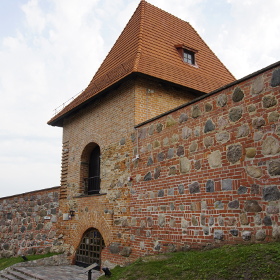
The Bastion of the Vilnius Defensive Wall
| Monday | Closed | Additional information |
| Tuesday | 10.00 – 18.00 | |
| Wednesday | 10.00 – 18.00 | |
| Thursday | 10.00 – 18.00 | |
| Friday | 10.00 – 18.00 | |
| Saturday | 10.00 – 18.00 | |
| Sunday | 10.00 – 18.00 |
Excursions
Guided tours are available in the Lithuanian, Russian and English languages. Guided tours must be ordered in advance by phone, e-mail or by filling this form: press here.
tel. +370 (5) 261 21 49
E-mail: [email protected]
Information for disabled visitors: the main exhibition halls of the Bastion of the Vilnius defensive wall have wheelchair access.
The tours in the museum are only led by the museum tour guides or the tour guides from the institution with which the museum has concluded an appropriate agreement.
General visitor regulations of the National Museum of Lithuania
 The territory of the Higher and Lower Castles of Vilnius was well fortified. However, the city was growing, its territory was expanding and the castle was no longer sufficient enough to protect the town-dwellers. Following the Battle of Grundwald in 1410, the city of Vilnius was safe until the beginning of the 16th century. During that period the city continued to grow and expanded far beyond the territory of the castles.
The territory of the Higher and Lower Castles of Vilnius was well fortified. However, the city was growing, its territory was expanding and the castle was no longer sufficient enough to protect the town-dwellers. Following the Battle of Grundwald in 1410, the city of Vilnius was safe until the beginning of the 16th century. During that period the city continued to grow and expanded far beyond the territory of the castles.
At the end of the 15th – the beginning of the 16th centuries, the emerging centralized state of Russia posed threat to Lithuania. At the request of the dwellers of Vilnius, Grand Duke of Lithuania Alexander (1492–1506) ordered to build a defensive wall of the city under the privilege of 1503. All the inhabitants of the city had to take part in the construction works. Those who were unable to build a brick wall had to erect a wall of sharpened wooden stakes. Vilnius Voivode Michal Radziwill delineated the boundaries of the wall. In 1522, the construction works of the defensive wall were completed. The wall contained five gates; however, already at the beginning of the 17th century the wall comprised ten gates and two defensive towers. During the first half of the 17th century, a bastion was erected in the Tower Hill near the defensive wall.
The bastion was a fortified defensive building built of earth and brick intended for the defence of the city. The bastion was comprised of a tower, a horseshoe-shaped part where artillery was stored, and a connecting tunnel. It is considered that the bastion was designed by military engineer Fryderyk Getkant. There is no precise information as to when the bastion was built. The fortification must have been erected following the dramatic political and military events of the 16th-17th centuries. The fact that the bastion was constructed later than the defensive wall is confirmed by archaeological investigations, written sources, and the plans of the city of Vilnius from various periods. The fact that the bastion had already been built at the beginning of the 17th century is evidenced by the August 9, 1627 document of representative of Vilnius Voivodeship Jonas Jundila. On that day the defensive wall of the city was inspected and its technical status was evaluated. The bastion is also mentioned in the document; however, no information is given about its status as this fortification was newly erected.
During the 1654-1667 war with Tsar of Moscow Aleksey Mikhailovich (1645–1676), Vilnius was occupied by the Russian army for the period from 1655 to 1661. The defensive wall of the city and the bastion were badly damaged. In 1661, the forces of the Grand Duchy of Lithuania reclaimed the city of Vilnius, and all the defensive fortifications damaged during the war were renovated and reconstructed. However, during the Northern War (1700–1721), Vilnius once again suffered great damage inflicted by foreign military forces.
Gradually, the bastion lost its defensive function. In the middle of the 18th century, the building was still on the surface of the ground as it is marked clearly in the 1753 plan by Georg Max von Fürstenhoff. Subsequent city plans made in 1793-1862 contain no marks of the bastion with the exception of the tower in the city plan of 1793. Due to the effort of the tsarist administration, practically all the defensive fortifications of the city of Vilnius were demolished at the beginning of the 19th century, whereas the territory of the bastion was turned into the dumpsite of the city with its ditches and walls buried under the ground.
In 1966, archaeological and architectural investigations as well as the reconstruction works of the bastion were commenced – the tower was rebuilt and covered with a roof, the interior of the cannon room and the tunnel linking the tunnel with the room were renovated.
In 1987, the museum was opened in the bastion.
| Tickets | |
| Adults | 4,00 € |
| Reduced price ticket* | 2,00 € |
| Family ticket | |
| 1 Adult and 1–3 minor children (60 min) | 6,00 € |
| 2 Adults and 1–3 minor children (60 min) | 10,00 € |
| Additional services | |
| Guided tour in Lithuanian for a group of up to 20 persons | 10,00 € |
| Guided tour in other languages for a group of up to 20 persons | 15,00 € |
| Price of an educational class for a participant | 1,00 € |
| Audioguide | 1,00 € |
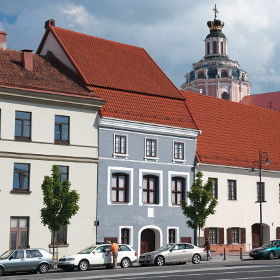
Kazys Varnelis House-Museum
| Monday | Closed | Additional information |
| Tuesday | Closed | |
| Wednesday | 10.00 – 18.00 | |
| Thursday | 10.00 – 18.00 | |
| Friday | 10.00 – 18.00 | |
| Saturday | 10.00 – 18.00 | |
| Sunday | 10.00 – 18.00 |
Excursions
Individual visitors who have purchased a ticket can attend only 14 of 43 exhibition halls, including temporary exhibitions. The rest of the museum can be visited only with a tour guide. Guided tours, depending on the price, can be themed (up to 1 hour) or exclusive, during which visitors are admitted to the personal library and studio of the artist. Guided tours are available in the Lithuanian, Russian and English languages. Guided tours must be ordered in advance by phone, e-mail or by filling this form: press here.
tel. +370 (5) 279 16 44
E-mail: [email protected]
Information for disabled visitors: exhibition halls of the Kazys Varnelis House-Museum do not have wheelchair access.
The tours in the museum are only led by the museum tour guides or the tour guides from the institution with which the museum has concluded an appropriate agreement.
General visitor regulations of the National Museum of Lithuania
 The Kazys Varnelis House-Museum is established in one of the oldest surviving brick buildings of Town Hall Square, the former houses of the Small Guild and the Masalski family, in Didzioji Street, Vilnius. These are perfect examples of Vilnius Gothic dating back to the beginning of the 15th century. The buildings have impressive basements with Gothic cross and cylindrical arches decorated with 18th century paintings. The arches on the first floor are also Gothic. There are plenty of authentic elements of the old architecture such as the openings of niches, windows, and doors.
The Kazys Varnelis House-Museum is established in one of the oldest surviving brick buildings of Town Hall Square, the former houses of the Small Guild and the Masalski family, in Didzioji Street, Vilnius. These are perfect examples of Vilnius Gothic dating back to the beginning of the 15th century. The buildings have impressive basements with Gothic cross and cylindrical arches decorated with 18th century paintings. The arches on the first floor are also Gothic. There are plenty of authentic elements of the old architecture such as the openings of niches, windows, and doors.
For a very long period of time the house of the Small Guild had belonged to the Mamonicz family of merchants, and from 1608 it was owned by the Brotherhood of Merchants of the City of Vilnius. The building housed warehouses, artisan workshops, inns, and a pharmacy. The building was reconstructed on a regular basis and additional premises were added. During the World War II, it was damaged badly. In 1957, the building was restored and housed a newly opened shop and residential apartments.
The nearby building referred to as the house of the Masalski family located in the 16th century residential quarter belonged to the Masalski family in 1645, and was later possessed by various other owners. During the fire of 1749, the building was badly damaged. Gradually, it also housed various shops and residential apartments. This building is famous for its Gothic kitchen with an open hearth, which is an exceptionally rare phenomenon in Vilnius.
From 1985, the reconstruction works of the two buildings were being performed in order to uncover the elements of the old architecture and to restore an authentic picture of the buildings. In 1993, following the decision of the Vilnius City Council, the buildings were given for the Kazys Varnelis Museum.
| Tickets for individual visitors | |
| Adults | 5,00 € |
| Reduced price ticket* | 2,00 € |
| Family ticket | |
| 1 Adult and 1–3 minor children | 8,00 € |
| 2 Adults and 1–3 minor children | 12,00 € |
| Guided tour for single visitors | |
| Guided tour for single visitor | 8,00 € |
| Exclusive guided tour | 17,00 € |
| Guided tour for groups (from 4 to 10 persons) | |
| Themed guided tour for a group | 30,00 € |
| Exclusive guided tour for a group | 50,00 € |
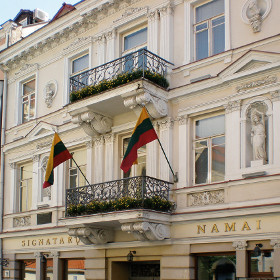
The House of Signatories
| Monday | Closed | Additional information |
| Tuesday | 10.00 – 18.00 | |
| Wednesday | 10.00 – 18.00 | |
| Thursday | 10.00 – 18.00 | |
| Friday | 10.00 – 18.00 | |
| Saturday | 10.00 – 18.00 | |
| Sunday | Closed* |
* except the last Sunday of each month
Excursions
Guided tours are available in the Lithuanian, Russian and English languages. Guided tours must be ordered in advance by phone, e-mail or by filling this form: press here.
tel. +370 (5) 231 44 37
E-mail: [email protected]
Information for disabled visitors: exhibition halls of the House of the Signatories have wheelchair access. Please ring the bell at the door.
The tours in the museum are only led by the museum tour guides or the tour guides from the institution with which the museum has concluded an appropriate agreement.
General visitor regulations of the National Museum of Lithuania
 The house of the Signatories of the Act of Independence of Lithuania is a historical and architectural monument, where the Act on the Restoration of Independence of Lithuania was signed on February 16, 1918.
The house of the Signatories of the Act of Independence of Lithuania is a historical and architectural monument, where the Act on the Restoration of Independence of Lithuania was signed on February 16, 1918.
The house currently marked No.26, situated in Pilies Street, Vilnius, was first mentioned in written sources in the Royal Privilege of April 18, 1645 granted to the Burgomaster of Vilnius and exempting him from the duty to accommodate guests. At the end of the 17th – 18th centuries, various owners of the house were mentioned. After the fires raging in Vilnius in 1748 and 1749, the house was rebuilt, and the third floor was added. Until 1789, the building was in possession of the church. Subsequently, the building was given to seculars and housed a goldsmith’s workshop, a shop offering a wide range of goods, and an inn. During the second half of the 19th century, the house was purchased by Karl and Jozefa Sztral.
At the end of the 19th century, the building was reconstructed in a Neo-Renaissance style with an enclosed courtyard according to the project made by architect Alexiey Polozov. Following the death of his father, third category merchant Kazimierz Sztral inherited the house. The daughters of Kazimierz Sztral managed the building until the nationalization in 1940. In the building, a cafe was opened and apartments were rented to artisans, merchants, and teachers. In September 1914, the apartment on the third floor was rented by the Lithuanian Society to Aid War Victims. In these very premises, the Council of the Lithuanian State gathered for a historical meeting and signed the Act of Independence of Lithuania on February 16, 1918. Following the occupation of Vilnius by Poland, the Lithuanian Society of Charity, which took over the activities of the Lithuanian Society to Aid War Victims, was established in the apartment. In 1928, pedagogue, cultural and public figure Povilas Karazija settled in the apartment. Teacher at the Vytautas Magnus Gymnasium Antanas Krutulys, who played a significant role in the culture of Vilnius region, moved to the apartment in 1931. Future historian of culture and museologist Vincas Zilenas, who studied at Vilnius University at that time, also lived temporarily in the premises on the third floor of the building. After the World War II, the room where the Act of Independence of Lithuania had been signed was transformed into a one-room flat.
In 1992, the first Vilnius City Council of restored independent Lithuania adopted a decision to establish the House of Signatories of the Act of Independence of Lithuania in this building. In 1998, the Municipality of Vilnius assigned the building to the Ministry of Culture. In 2003, the House of Signatories became a branch of the National Museum of Lithuania. Various events related to the history of the statehood of Lithuania are held in the hall of the House of Signatories.
| Tickets | |
| Adults | 4,00 € |
| Reduced price ticket* | 2,00 € |
| Family ticket | |
| 1 Adult and 1–3 minor children | 6,00 € |
| 2 Adults and 1–3 minor children | 10,00 € |
| Additional services | |
| Guided tour in Lithuanian in a group of up to 20 persons (60 min) | 10,00 € |
| Guided tour in other languages in a group of up to 20 persons (60 min) | 15,00 € |
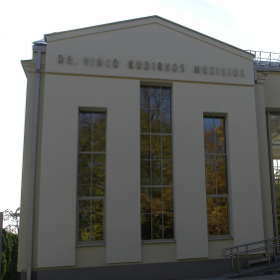
Vincas Kudirka Museum
| Monday | Closed | Additional information |
| Tuesday | 10.00 – 17.00 | |
| Wednesday | 10.00 – 17.00 | |
| Thursday | 10.00 – 17.00 | |
| Friday | 10.00 – 17.00 | |
| Saturday | 10.00 – 17.00 | |
| Sunday | Closed* |
* except the last Sunday of each month
Excursions
tel. +370 (345) 5 74 51
E-mail: [email protected]
Guided tours are available in the Lithuanian language.
Information for disabled visitors: exhibition halls of the Vincas Kudirka Museum have wheelchair access.
General visitor regulations of the National Museum of Lithuania

The beginning of the Vincas Kudirka Museum goes back to the Kudirkos Naumiestis secondary school, where a study group of young historians operated from the late 1950s. A large amount of material was accumulated during several decades, and in 1998, the new Vincas Kudirka Museum was built on the initiative of the Vincas Kudirka Foundation. The museum building was designed by the winner of the National Award for Culture and Arts in 2016, architect Audrius Ambrasas, and was erected on the site of the house where Kudirka lived when he created the Lithuanian national anthem, Tautiška giesmė, in 1898.
On 14 September 1998, by a decree of the Minister of Culture, the Vincas Kudirka Museum became a branch of the National Museum of Lithuania, and on December 5 of the same year, on the occasion of the 100th anniversary of the creation of Tautiška giesmė and the 140th anniversary of Vincas Kudirka’s birth, the ceremonial opening of the museum took place.
In 2015–2016, the building underwent major repairs. On 10 February 2017, a new permanent exhibition was opened.
| Tickets | |
| Adults | 2,00 € |
| Reduced price ticket* | 1,00 € |
| Family ticket (2 adults and 3 children) | 5,00 € |
| Additional services | |
| A guided tour for a group of up to 20 people (60 min) | 5,00 € |
| Price of an educational class for a school pupil | 1,00 € |
 V. Kudirkos Str. 29, Kudirkos Naumiestis, LT-71317 Šakių r.
V. Kudirkos Str. 29, Kudirkos Naumiestis, LT-71317 Šakių r. tel. +370 (345) 5 74 51
tel. +370 (345) 5 74 51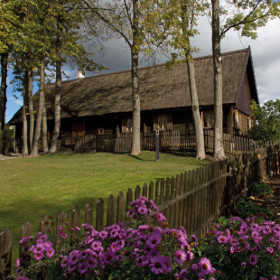
Jonas Basanavicius Birthplace
| Monday | 09.00 – 17.00 | Additional information |
| Tuesday | 09.00 – 17.00 | |
| Wednesday | 09.00 – 17.00 | |
| Thursday | 09.00 – 17.00 | |
| Friday | 09.00 – 17.00 | |
| Saturday | 10.00 – 17.00 | |
| Sunday | Closed* |
* except the last Sunday of each month
Excursions
tel. +370 (342) 6 93 65
E-mail: [email protected]
Guided tours are available in the Lithuanian language.
The tours in the museum are only led by the museum tour guides or the tour guides from the institution with which the museum has concluded an appropriate agreement.
Information for disabled visitors: exhibition rooms of the Jonas Basanavičius homestead do not have wheelchair access.
General visitor regulations of the National Museum of Lithuania
Information is being prepared.
Oak Grove of the National Revival of Lithuania
 The upsurge of national revival called the nation into meetings drawing thousands of people and gave rise to numerous initiatives related with historical memory. In the autumn of 1988 the engineer Vitalius Stepulis, the teacher Algimantas Kepežėnas, the economist Vygandas Čaplikas, the park researcher Kęstutis Labanauskas, the geographer Rimantas Krupickas, the specialist in agriculture Vladas Markauskas and the geoscientist Romualdas Survila advanced an idea to plant an oak grove in the Sūduvian land, in the birthplace of the patriarch of the national revival of Lithuania Jonas Basanavičius. On 1, 8 and 15 April 1989 an oak grove of approximately 8,000 trees was planted in an area of 30 hectares by circa 3,500 planters. The homestead of Jonas Basanavičius was restored after a design by the architect Živilė Mačionienė. The oak grove has been growing each year, and today it boasts circa 9,000 trees.
The upsurge of national revival called the nation into meetings drawing thousands of people and gave rise to numerous initiatives related with historical memory. In the autumn of 1988 the engineer Vitalius Stepulis, the teacher Algimantas Kepežėnas, the economist Vygandas Čaplikas, the park researcher Kęstutis Labanauskas, the geographer Rimantas Krupickas, the specialist in agriculture Vladas Markauskas and the geoscientist Romualdas Survila advanced an idea to plant an oak grove in the Sūduvian land, in the birthplace of the patriarch of the national revival of Lithuania Jonas Basanavičius. On 1, 8 and 15 April 1989 an oak grove of approximately 8,000 trees was planted in an area of 30 hectares by circa 3,500 planters. The homestead of Jonas Basanavičius was restored after a design by the architect Živilė Mačionienė. The oak grove has been growing each year, and today it boasts circa 9,000 trees.
In 1998 the Government of Lithuania granted the status of cultural monument to the Oak Grove of the National Revival and Jonas Basanavičius’s birthplace. Since 2010 these two cultural monuments are branches of the National Museum of Lithuania.
The Altar Hill is the highest spot of the oak grove. It is becoming a site of paying respect to the newly forming traditions and memorable dates of the Lithuanian nation. In the Oak Grove of the National Revival of Lithuania 13 groves were planted to commemorate the most significant dates of the state’s history. On 26 April 2014 the first cluster of 25 oak trees was planted in commemoration of the 100th anniversary of the restoration of the Lithuanian state.
In the Grove of the Nation’s Memory, oak trees dedicated to Dr Jonas Basanavičius, Simonas Daukantas, Antanas Poška, Vydūnas, the presidents of the Republic of Lithuania and other prominent figures were planted.
Oaks were planted in the Grove of the Signatories of the Act of February 16th to commemorate and pay tribute to the signatories of the Act of Independence of 16 February 1918.
Grove of the Victims of Repressions is dedicated to the people of Lithuania who were subject to repressions and genocide.
Grove of the People of Vilkaviškis is dedicated to the honourable people of the land in which the oak grove is situated.
In the Grove of the Winners of the Jonas Basanavičius State Award, an oak tree is planted each year in commemoration of the winner of the state award for positive creative and scholarly activity in the field of ethnic culture.
The oaks growing in the Grove of National Unity remind all people of Lithuania that the strength is in unity.
Youth Grove symbolises the continuity of generations in the building of the state and the protection of the nation’s values and independence.
Grove of Lithuanians in the World reminds Lithuanians that one fourth of their compatriots live abroad.
In the centre of the Grove of Book Smugglers stands an altar composed of stones brought from the birthplaces of book smugglers. The Grove of Book Smugglers consists of circa 150 oak trees, 115 of which are dedicated to concrete persons. Book smugglers who used to smuggle Lithuanian publications from Prussia in the period of the Lithuanian press ban from 1864 to 1904 helped preserve the national language.
Ring of Birch Trees of the Sąjūdis Seimas. In the spring of 1991 birch trees were planted in a 35-metre diameter ring to pay tribute to the Sąjūdis constituent assembly, which took place on 22–23 October 1988, and the members of the initiative group of the Lithuanian Reform Movement Sąjūdis.
Grove of the Balts is dedicated to the memory of the Lithuanian ancestors. The earliest written information about the Balts goes back to the 5th century B.C. In the 12th century the Baltic tribes of Prussians, Galindians, Skalvians, Yotvingians, Suduvians, Curonians, Semigallians, Selonians, Latgalians, Lithuanians and Dnieper Balts were mentioned. The two surviving Baltic nations are Latvians and Lithuanians.
Oak trees were planted in the Grove of the Signatories of the Act of March 11th to commemorate and pay respect to the signatories of the Act of Independence of 11 March 1990.
Grove of March 11th. The fifty-year occupation ended with a brave and peaceful restoration of the independent Republic of Lithuania on 11 March 1990. Eleven oak trees in this grove are clustered around the highest hill in the environs, southwest of Jonas Basanavičius’s birthplace.
| Tickets | |
| Adults | 2,00 € |
| Reduced price ticket* | 1,00 € |
| Family ticket (2 adults and 3 children) | 5,00 € |
| Additional services | |
| Price of an educational class for a school pupil | 1,00 € |
| A guided tour for a group of up to 20 people (60 min.) | 10,00 € |
| An educational programme for adults (a group of up to 20 people) | 2,00 € |
| Filming and taking of pictures in the farmstead at Jonas Basanavicius birthplace | 10,00 € |
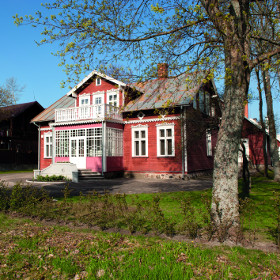
The Palanga Burgomaster Jonas Sliupas Museum
| Monday | Closed | Additional information |
| Tuesday | Closed | |
| Wednesday | 11.00 – 18.00 | |
| Thursday | 11.00 – 18.00 | |
| Friday | 11.00 – 18.00 | |
| Saturday | 11.00 – 18.00 | |
| Sunday | 11.00 – 17.00 |
Excursions
tel. +370 (460) 5 45 59
E-mail: [email protected]
Guided tours are available in the Lithuanian and Russian languages. Guided tours in a foreign language must be ordered in advance by phone or e-mail.
The tours in the museum are only led by the museum tour guides or the tour guides from the institution with which the museum has concluded an appropriate agreement.
Information for disabled visitors: exhibition rooms of the Jonas Šliūpas memorial homestead do not have wheelchair access.
General visitor regulations of the National Museum of Lithuania
Information is being prepared.
| Tickets | |
| Adults | 2,00 € |
| Reduced price ticket* | 1,00 € |
| Family ticket (2 adults and 3 children) | 5,00 € |
| Additional services | |
| A guided tour for a group of up to 20 people | 5,00 € |
| Price of an educational class for a school pupil | 1,00 € |
 Back
Back






